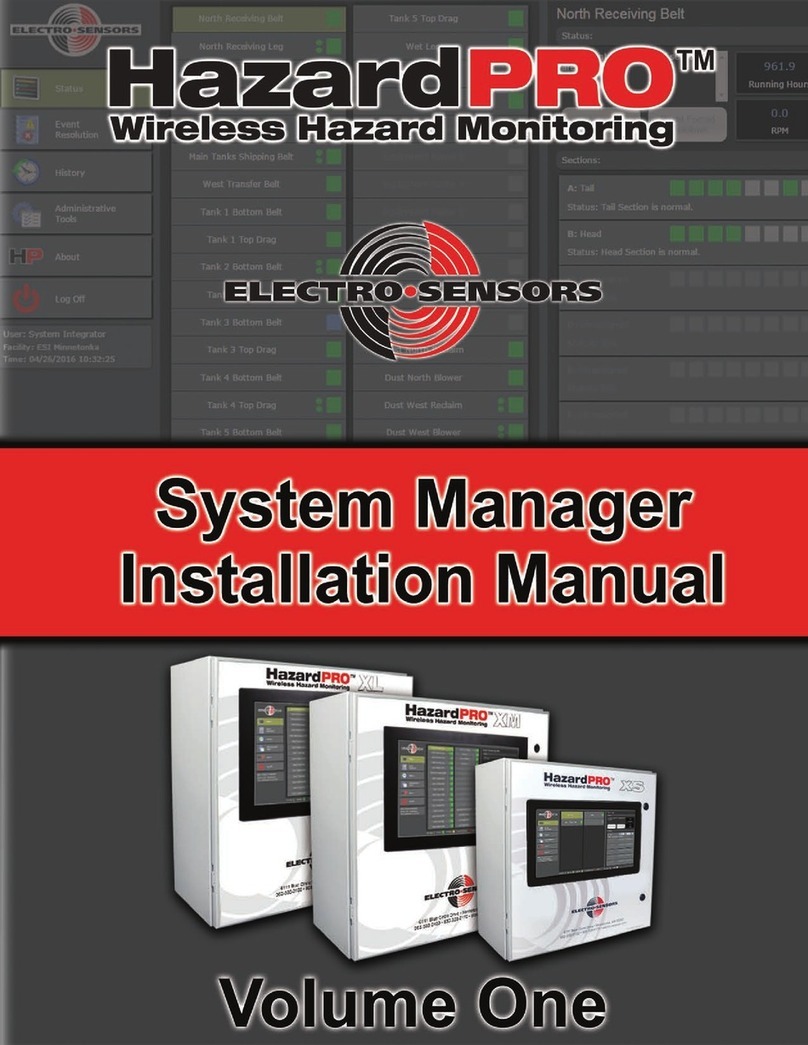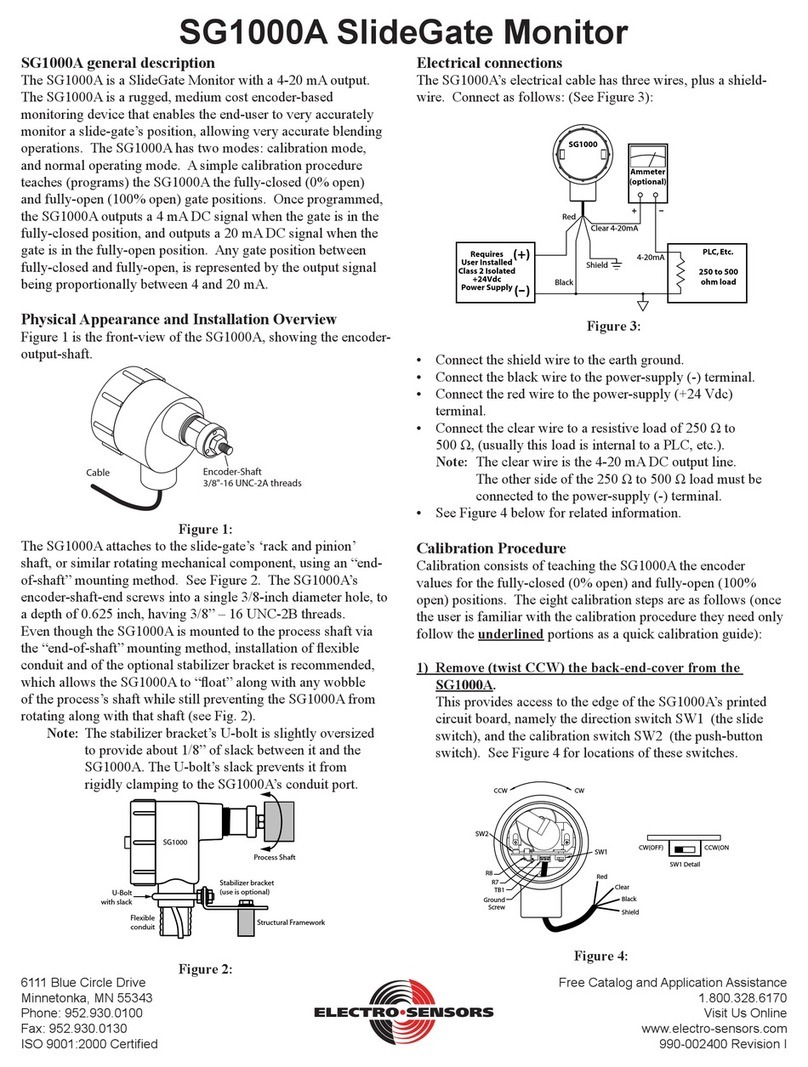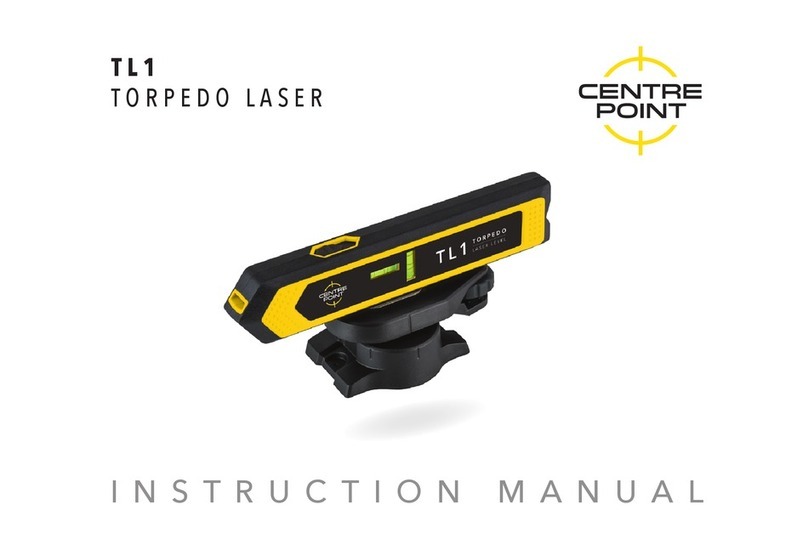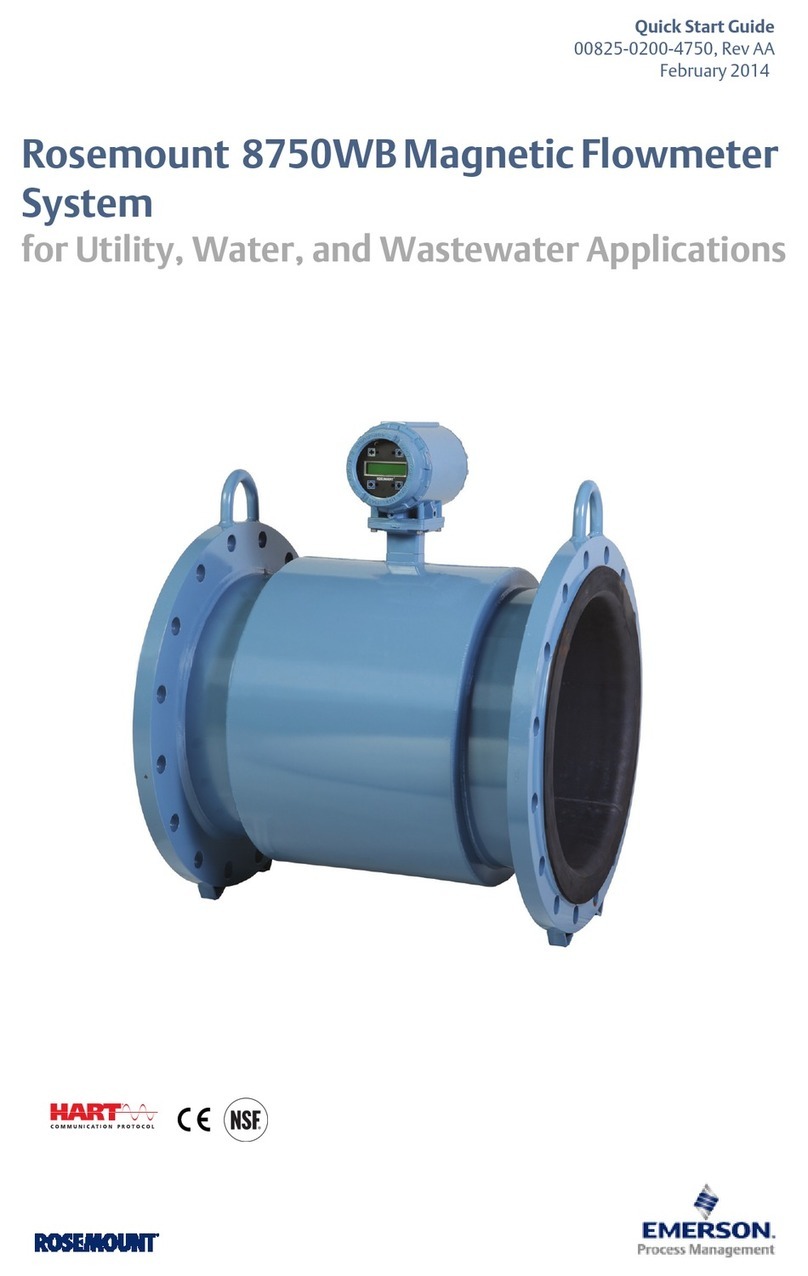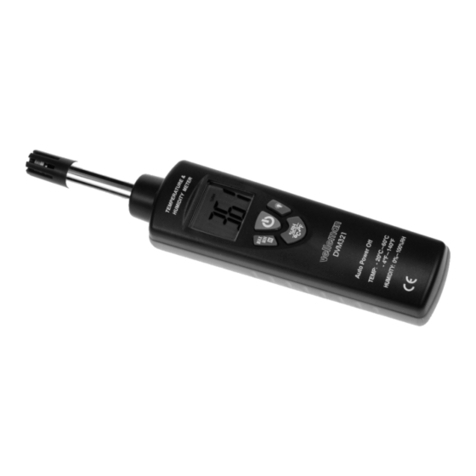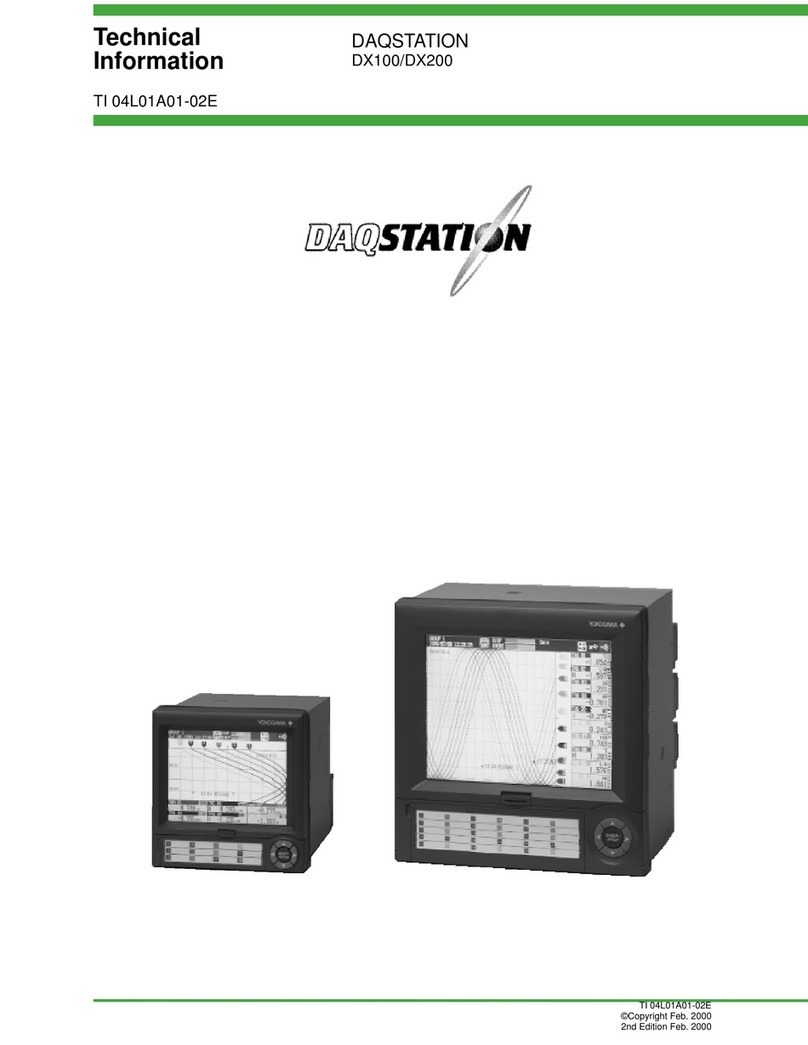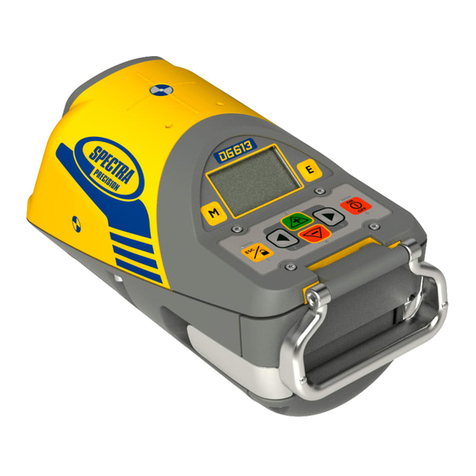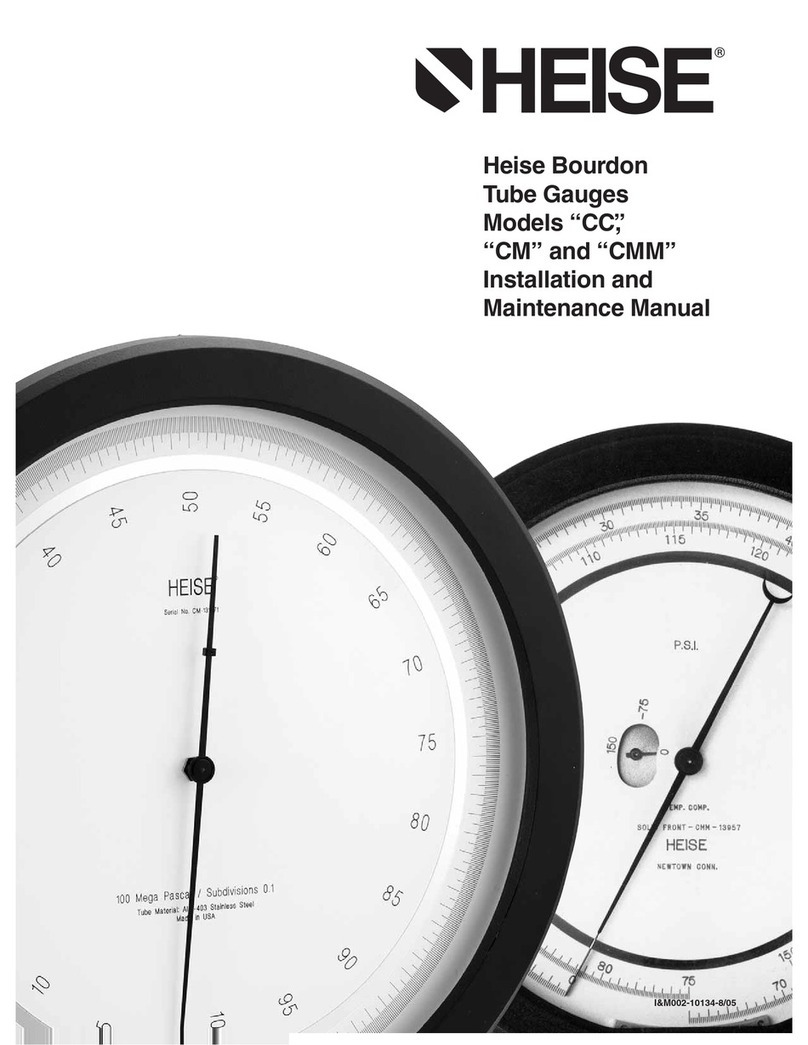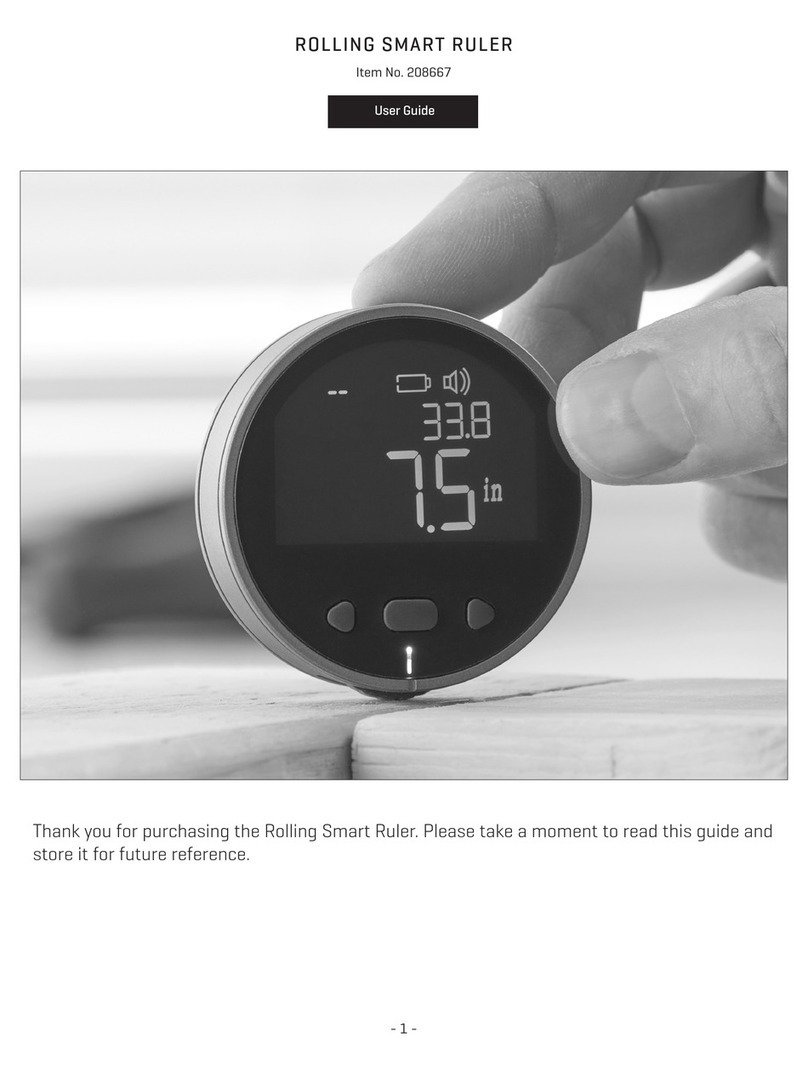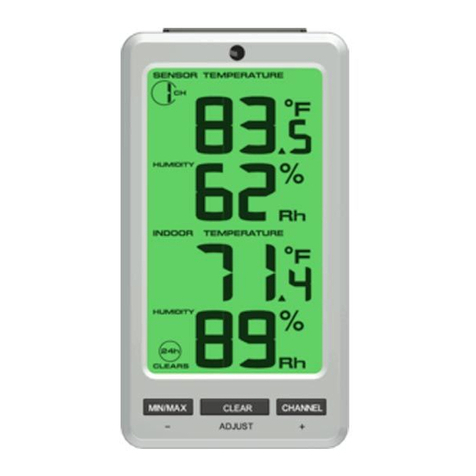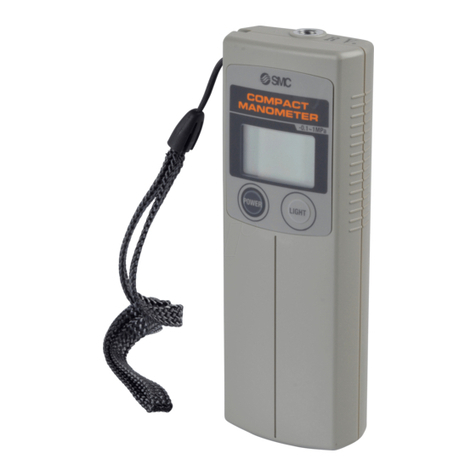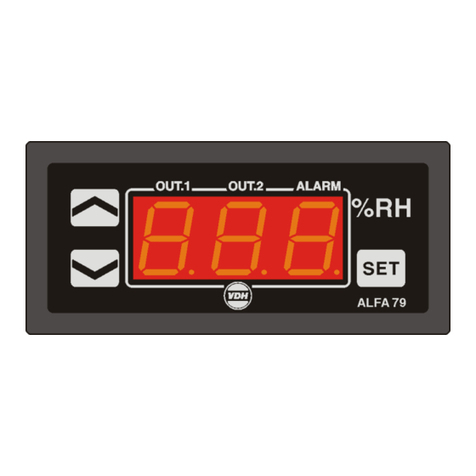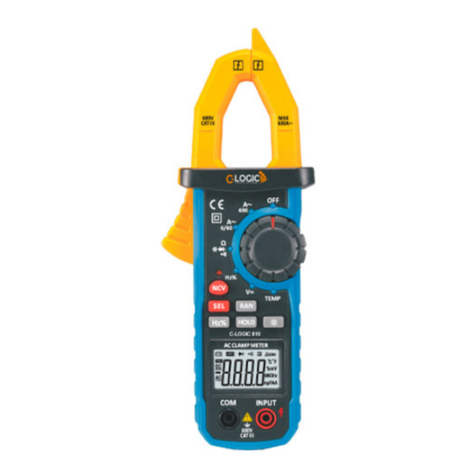Electro-Sensors TR400 User manual

Model TR400
Programmable Process Ratemeter
Installation & Operation Manual

Release Date: Oct, 2012
Model TR400
Programmable Process Ratemeter
Installation and Operation Manual
Part Number: 990−000500
Revision G
Electro-Sensors®, Inc.
6111 Blue Circle Drive
Minnetonka, MN 55343-9108
Contact us at:
Local: 952-930-0100
National: 1-800-328-6170
Fax: 952-930-0130
Web: www.electro-sensors.com
Sales www[email protected]
Support: [email protected]

i
Rev G
Introduction To This Manual
What is in this
manual? This installation and operations manual provides detailed technical information about
the TR400 Programmable Process Ratemeter. It should serve as your technical
resource to install, set up, operate, and test the TR400.
Who should use
this manual
(audience)
Keep in mind that the function of the TR400 installed in a mechanical process is to
monitor speed and direction; therefore, it must be installed by qualified personnel
only. This manual is designed for persons who have the primary responsibility to
install, set up, operate, and test the TR400.
The secondary audience would be those persons seeking technical information about
the electrical concepts and operation of the TR400.
Knowledge
level Persons installing, setting up, and operating the TR400 should have good knowledge
and understanding of electrical and mechanical concepts and principals pertaining to
Programmable Process Ratemeters. Again, the TR400 should be installed by
qualified personnel only.
Notices •Installing Electro-Sensors, Inc., products is the responsibility of the purchaser,
and is in no way guaranteed by Electro-Sensors, Inc.
•While the information in this manual has been carefully reviewed, Electro-
Sensors, Inc., assumes no liability for any errors or omissions in this manual.
Additionally, Electro-Sensors, Inc., reserves the right to make changes to any
part of the information in this manual or the product described herein without
further notices.
•No part of this manual may be photocopied, reproduced, or translated to another
language without the prior written consent of Electro-Sensors, Inc.

ii
Rev G
Introduction To This Manual
How this manual is organized
Manual
navigation tools This manual contains the following navigation tools:
•Table of contents
•Beginning section table of contents
•Index
Each is designed to help you find the information you need quickly.
Manual
sections This manual is divided into the following sections:
•Section 1: Warnings and Cautions, discusses personal injury possibilities and
potential damage to equipment.
•Section 2: TR400 Installation, discusses installing the TR400 into a panel.
•Section 3: TR400 Wiring and DIP Switches, discusses practical wiring
practices, wiring schematics, and configuring DIP switches.
•Section 4: TR400 Setup, discusses the TR400 parts and functions, and set up
information.
•Section 5: TR400 Programming, discusses programming the operational
variables of the TR400.
•Section 6: TR400 Diagnostics, discusses the tests used to verify the operation
and functionality of the TR400.
•Appendix A: TR400 Specifications, discusses the specifications for the TR400.

iii
Rev G
Table of Contents
How this manual is organized..........................................................................................................ii
T
ABLE OF
C
ONTENTS
...............................................................................................................................
III
S
ECTION
1.................................................................................................................................................1
W
ARNINGS
&
C
AUTIONS
..........................................................................................................................1
Introduction......................................................................................................................................1
About warnings and cautions...........................................................................................................2
Warnings..........................................................................................................................................3
Cautions...........................................................................................................................................4
S
ECTION
2.................................................................................................................................................5
TR400
I
NSTALLATION
..............................................................................................................................5
Introduction......................................................................................................................................5
Installation overview........................................................................................................................6
Installing the TR400 ........................................................................................................................7
S
ECTION
3.................................................................................................................................................9
TR400
W
IRING
&
DIP
S
WITCHES
.............................................................................................................9
Introduction......................................................................................................................................9
Recommended wiring practices.....................................................................................................10
TR400 wiring schematics ..............................................................................................................11
4-20 mA/0-10 Vdc analog output ..................................................................................................13
Switch input wiring........................................................................................................................14
Single-channel and quadrature signal wiring.................................................................................15
A and B channel input signal wiring..............................................................................................16
TR400 DIP switches......................................................................................................................17
S
ECTION
4...............................................................................................................................................19
TR400
S
ET
-U
P
P
ARAMETERS
.................................................................................................................19
Introduction....................................................................................................................................19
TR400 parts and functions.............................................................................................................20
TR400 set-up parameters...............................................................................................................22
S
ECTION
5...............................................................................................................................................23
TR400
P
ROGRAMMING
...........................................................................................................................23
Introduction....................................................................................................................................23
Programmable variables.................................................................................................................24
How to select a variable and view its data.....................................................................................27
Keypad keys used to access and program variables ......................................................................29
How to select and change a variable’s numerical value ................................................................30
Programming rate and signal parameters.......................................................................................32
Programming the display operation...............................................................................................33
Programming the relay outputs......................................................................................................35
Programming the analog output.....................................................................................................38
Programming the switch inputs .....................................................................................................39
Programming the display features .................................................................................................40

iv
Rev G
Table of Contents
S
ECTION
6...............................................................................................................................................41
TR400
D
IAGNOSTICS
..............................................................................................................................41
Introduction....................................................................................................................................41
Keypad and display test.................................................................................................................42
Relay output test ............................................................................................................................43
Switch input test.............................................................................................................................44
Analog output calibration ..............................................................................................................45
Resetting the variables...................................................................................................................47
Setting and changing the security code number.............................................................................48
System slowdown test....................................................................................................................50
Viewing shaft deviation.................................................................................................................51
Clearing the LRC code...................................................................................................................52
TR400
S
PECIFICATIONS
..........................................................................................................................53
I
NDEX
......................................................................................................................................................55

1
Rev G
Section 1
Warnings & Cautions
Introduction
This section discusses warnings and cautions to guard against the possibility of
injury to persons and damage to equipment. Since the TR400 monitors the speed and
direction of various mechanical systems, observe all warnings and cautions that
pertain to the mechanical systems as well.
In this section These are the topics:
Topic See Page
About warnings and cautions 2
Warnings 3
Cautions 4

2Rev G
S1−
−−
−Warnings & Cautions
Caution
Warning
About warnings and cautions
Important
notice Read through the warnings and cautions in this section before attempting to install,
set up, or operate the TR400. Warnings and cautions appear in this section and
throughout this manual.
Definitions Warnings are given when there is the possibility of injury to persons.
Cautions are given when there is the possibility of damage to equipment.
The warning label will appear as follows:
The caution label will appear as follows:
Continued on next page

3
Rev G
S1−
−−
−Warnings & Cautions
Warnings
Always turn the power source OFF before wiring the TR400. Failure to observe this warning
could result in an electrical shock or damage to the equipment.
During a Stop condition, any slight movement of the shaft or magnetic disc could activate the
control relay and start the motor. To prevent starting the motor accidentally, always use proper
LOCKOUT, TAG OUT procedures. Failure to observe this warning could result in an injury to
persons or damage to equipment.
Do not touch the Pulser Disc or Wrap while it is spinning. Failure to observe this warning could
result in a hand injury.
Always wear protective eye goggles when using power tools. Failure to observe this warning
could result in an eye injury or blindness.
Practical wiring practices must be followed when wiring industrial equipment such as the
TR400. Failure to follow practical wiring practices could result in an injury to persons or damage
to equipment.
The TR400 is a programmable process ratemeter and must be installed by qualified personnel
only. Failure to observe this warning could result in an injury to persons or damage to
equipment.
Only qualified personnel should attempt to connect any wires to the TR400. Failure to observe
this warning could result in an injury to persons.
Continued on next page
Warning
Warning
Warning
Warning
Warning
Warning
Warning

4Rev G
S1−
−−
−Warnings & Cautions
Cautions
Power to sensors is provided at TB2
−
6 (+12 Vdc) and TB2
−
5 (common) on the TR400. Wiring
to those inputs should be shielded cable with the shield tied to TB2
−
5 common only. Failure to
observe this caution could result in improper sensor function.
Always turn the power source OFF before wiring the TR400. Failure to observe this caution
could result in damage to the TR400.
Never use shielded cable
U
with extra conductors
U
. Extra conductors can act as antennas, picking
up electrical noise. Failure to observe this caution could result in improper sensor operation.
The TR400 standard uses 115 Vac, 6 VA @ 60/50 Hz, with 230 Vac as an option. Make sure
you know the correct supply voltage before applying power to the TR400. Failure to observe
this caution could result in damage to the TR400.
Do not touch the Pulser Disc or Wrap while it is spinning. Failure to observe this caution could
cause an interruption in pulse generation, resulting in a disruption in the mechanical process
being monitored.
When the digital input function is programmed as a Reset input and the switch input remains
closed, the relay will never turn OFF regardless of the operating condition. A momentary
contact closure of the switch is advised. Failure to observe this caution could result in damage
to the equipment.
Only qualified personnel should attempt to connect any wires to the TR400. Failure to observe
this warning could result in damage to the equipment.
Caution
Ca
ution
Caution
Caution
Caution
Caution
Caution

5
Rev G
Section 2
TR400 Installation
Introduction
This section discusses unpacking and then installing the TR400 into a panel.
In this section These are the topics:
Topic See Page
Installation overview 6
Installing the TR400 7

6Rev G
S2−
−−
−TR400
Installation
Installation overview
The TR400 is a programmable process ratemeter and must be installed by qualified personnel
only. Failure to observe this warning could result in an injury to persons or damage to
equipment.
Unpacking the
TR400 After unpacking the TR400, save the following items:
•Packing list
•All instructions and other documentation
Verify that all parts were shipped via the packing list.
Continued on next page
Warning

7
Rev G
S2−
−−
−TR400 Installation
Installing the TR400
Panel cutout To install the TR400 into an instrument panel, do the following:
Step Action
1. Cut a rectangular hole in the panel to the dimensions shown in Figure 1.
2. Loosen the screws holding the mounting bracket to the TR400 and
remove it, as shown in Figure 1.
3. Slide the TR400 into the cutout.
4. Replace the mounting bracket and tighten the screws
do not over
tighten. See Figure 1.
Note: Allow a minimum of 1.5 inches of clearance on all sides of the TR400 (all
dimensions are in inches).
4.85"
3.10"
2.61"
4.31"
5.50"
4.28"
2.58"
Insert Mounting Bracket
Remove Mounting Bracket
Front
View
Panel
Cutout
6.25"
Side View
Top
View
Figure 1: TR400 Dimensions

8Rev G
S2−
−−
−TR400
Installation
Intentionally Left Blank

9
Rev G
Section 3
TR400 Wiring & DIP Switches
Introduction
This section discusses electrical information concerning the TR400, including wiring
practices, wiring schematics, and DIP-switch settings.
In this section These are the topics:
Topic See Page
Practical wiring practices 10
TR400 wiring schematics 11
4-20 mA/0-10 Vdc analog output 13
Switch input wiring 14
Single channel and quadrature signal wiring 15
A and B channel input signal wiring 16
TR400 DIP switches 17

10 Rev G
S3−
−−
−
TR400 Wiring & DIP Switches
Recommended wiring practices
Recommended wiring practices must be followed when wiring industrial equipment such as the
TR400. Failure to follow the practical wiring practices listed below could result in an injury to
persons or damage to equipment.
Wiring
practices The following is a list of recommended wiring practices for installing industrial
equipment. It is critically important that you observe and follow these wiring
practices when wiring the TR400.
•All control signals must be shielded cable. The shield must be tied to common or
earth ground at the receiving end only. In some environments, earth ground may
contain excessive electrical noise. If you encounter problems using earth ground
as a shield-tie point, switch the shields to signal common. All connections to the
controller are considered signal unless they carry AC voltage.
•Never use a shielded cable with unused conductors. The unused conductors act
as antennas. Attempting to tie the unused conductors to ground or other signal-
carrying wires will create different antenna configurations. In many cases, an
unshielded wire could be less susceptible to electrical noise. Always make sure
that a shielded cable with the correct number of conductors is pulled.
•All control signals must be separated from power wires. Power wiring includes
any AC or DC wires carrying voltages with a current potential of greater that one
(1) amp or a voltage greater than 24 volts. This includes, but is not limited to,
115 Vac, 230 Vac, and 460 Vac. Do not bundle shielded cables and power wires
together.
•Do not run signal cables along high magnetic or electrostatic generators. This
includes, but is not limited to motors, fans, contactors, igniters, etc. Aluminum
shielded cable does not stop magnetically induced noise; braided shielded cable
only partially reduces magnetically induced noise.
•An earth ground wire must be installed on microprocessor-based equipment
when required. Do not rely on the enclosure’s contact with the panel for earth
ground. Earth ground is often used in noise-rejection circuitry as well as for
safety.
•Contactors, solenoids, and relay coils connected to the same AC power source or
in the same enclosure panel as the controller must be suppressed with a
capacitor-resistor filter across the coil. These can be made with a 1 kV capacitor
and a ¼-watt resistor in series, or they can be purchased in a pre-made package.
Use a capacitance value of 0.1 µF or larger and a resistance value of 500 ohms or
less.
•When AC voltage is stepped down for use with equipment, a capacitor-resistor
network or a filter should be placed across the secondary.
Warning

11
Rev G
S3−
−−
−TR400 Wiring & DIP Switches
TR400 wiring schematics
Only qualified personnel should attempt to connect any wires to the TR400. Failure to observe
this warning could result in an injury to persons.
Do not wire the TR400 to 230 Vac or 10-30 Vdc unless it has been specially wired for that
voltage. The standard voltage setting is 115 Vac. Failure to observe this caution could result in
damage to the TR400.
Wiring
schematic Figure 2 shows the various wiring schemes for the TR400.
TB1
1
2
3
4
5
6
(+)
(-)
(+) Line(L1)
(-) Neutral(L2)
Line
(same potential
as TB1-1) 1
2
3
4
5
6
TB3
TB2
1
2
3
4
5
6
7
8
NC
Common
+12 V Supply
Signal A
Signal B
Quad Only
Relay
Output 2
Relay
Output 1
Offset Pot
Span Pot 4-20 mA
PLC
NC
DC power AC Power TB3
1
2
3
4
5
6
7
8
9
10
11
12
13
14
15
16
17
18
Relay
Output 1
Relay
Output 2
Relay
Output 3
Relay
Output 4
Relay
Output 5
Relay
Output 6
2 Relay option 6 Relay optionMain board
Figure 2: TR400 Wiring
Continued on next page
Caution
Warning

12 Rev G
S3−
−−
−
TR400 Wiring & DIP Switches
TR400 wiring schematics, continued
During a Stop condition, any slight movement of the shaft or magnetic disc could activate the
control relay and start the motor if the Motor Auxiliary, Normally Open Contact (MS Aux n.o.) is
not wired in series. To prevent starting the motor accidentally, always use the proper
LOCKOUT TAG OUT procedures. Failure to observe this warning could result in an injury to
persons or damage to equipment.
Motor
shutdown
schematic
Figure 3 shows a Stop Command Wiring schematic, designed to prevent an
accidental motor startup.
Figure 3: Wiring Schematic to Disable the Alarm on a Stop Command
Input power
wiring The TR400 standard comes set-up for 115 Vac, 6VA at 50/60 Hz. An external 1/16
amp slow-blow fuse must be provided by the customer. AC power will tie to TB1−1,
Line, and TB1−2, Neutral. Optionally it can be ordered in 230 Vac and 10-30 Vdc.
See Figure 2.
Warning
MS Motor Starter (not supplied)
OL Over Load
n.o. Normally open (relay is in a deactivated
state)
MS
TR400
Line Neutral
Start
Momentary
Internal
On TR400
Warning Light,
Horn, Solenoid, etc.
Internal
On TR400
Stop
Maintained
MS
Aux
MS OL
n.o.
Motor Shutdown with Alarm

13
Rev G
S3−
−−
−TR400 Wiring & DIP Switches
4-20 mA/0-10 Vdc analog output
4-20 mA/0-10
VDC analog
output
The 4-20mA output supports a maximum load resistance of 500 ohms. The analog
output plus (+) signal is at TB1−5, and the negative (-) signal is at TB1−4, as shown
in Figure 4. This applies for both 0-10VDC
1
and 4-20mA
See the Diagnostics section for additional information about the analog outputs.
1
2
3
4
5
6
TB1
(–)
(+)
Analog Output
Offset Pot
Span Pot
4-20 mA/0-10 Vdc
4–20 mA/
0–10Vdc
DC Power AC Power
(+) Line (L1)
(-) Neutral (L2) NC
Analog Output Aux
Figure 4: Wiring for Analog Outputs 4-20 mA/*0-10 Vdc
Analog Output
Aux Analog Output Aux is currently only used with the TR400 when the optional 6 relay
board is installed. When the 6 relay option board is installed, 4-20mA is output at
TB1-5 and 0-10Vdc is output at TB1-6. The common for both is at TB1-4. Only one
output can be calibrated at a time. Only one output should be connected and used at a
time.
1
When analog is ordered, 4-20mA is standard and 0-10VDC is optional.

14 Rev G
S3−
−−
−
TR400 Wiring & DIP Switches
Switch input wiring
Switch inputs
and wiring There are three (3) switch inputs that are programmable using variable 14. They are
used to Reset the outputs, or to freeze the display. Inputs 1, 2, and 3 require a voltage
equal to the supply voltage, which is at the same potential as the input Line (L1)
voltage. The opposite sides (non accessible) of these solid-state inputs are tied to
input Neutral (L2). Wire input 1 to TB2−1, input 2 to TB2−2, and input 3, to TB2−3.
See Figure 5.
TB1
1
2
3
4
5
6
TB2
1
2
3
4
5
6
7
8
DC Power AC Power
(+) Line (L1)
(-) Neutral (L2)
Switch Inputs
Figure 5: Wiring for Switch Inputs
Table of contents
Other Electro-Sensors Measuring Instrument manuals

